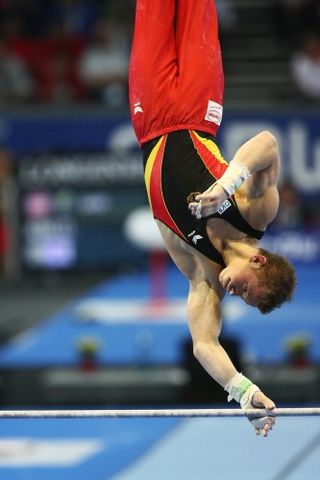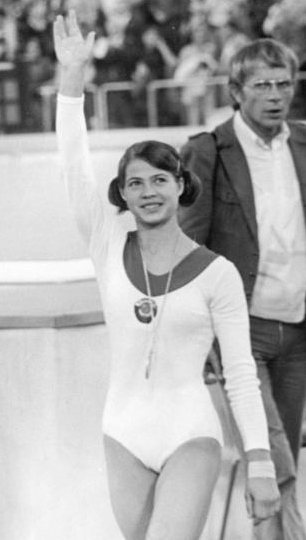
Gymnastics is a type of sport that includes physical exercises requiring balance, strength, flexibility, agility, coordination, artistry and endurance. The movements involved in gymnastics contribute to the development of the arms, legs, shoulders, back, chest, and abdominal muscle groups. Gymnastics evolved from exercises used by the ancient Greeks that included skills for mounting and dismounting a horse, and from circus performance skills.

The vault is an artistic gymnastics apparatus which gymnasts perform on, as well as the skill performed using that apparatus. Vaulting is also the action of performing a vault. Both male and female gymnasts perform the vault. The English abbreviation for the event in gymnastics scoring is VT.

The horizontal bar, also known as the high bar, is an apparatus used by male gymnasts in artistic gymnastics. It traditionally consists of a cylindrical metal bar that is rigidly held above and parallel to the floor by a system of cables and stiff vertical supports. Gymnasts typically wear suede leather grips while performing on the bar. Current elite-level competition uses a stainless steel core rail. The gymnastics elements performed on the horizontal bar are regulated by a Code of Points. A bar routine, which is a sequence of several bar skills, usually includes giants with various grips, in-bar work, turns, release and regrasp skills, and a dismount. The horizontal bar is often considered one of the most exciting gymnastics events due to the power exhibited by gymnasts during giant swings and spectacular aerial releases and dismounts that often include multiple flips or twists and, in some cases, airborne travel over the bar.

Ludmilla Ivanovna Tourischeva is a former Russian gymnast, Ukrainian gymnast coach, all-round Olympic champion and a nine-time Olympic medalist for the Soviet Union.

Yelena Viktorovna Davydova is a Russian-Canadian gymnastics coach and judge who competed for the former Soviet Union. She was the women's artistic individual all-around champion at the 1980 Summer Olympics in Moscow. She's the owner and head coach at Gemini Gymnastics, a gymnastics club in Oshawa, Ontario. In July 2012, Davydova was one of the coaches of the Canadian Women's Artistic Gymnastics Team. In 2016 Davydova was head floor judge at the 2016 Rio Olympics.

In gymnastics, the floor is a specially prepared exercise surface, which is considered an apparatus. It is used by both male and female gymnasts. The gymnastics event performed on the floor is called floor exercise. The English abbreviation for the event in gymnastics scoring is FX.

The balance beam is a rectangular artistic gymnastics apparatus and an event performed using the apparatus. Both the apparatus and the event are sometimes simply referred to as "beam". The English abbreviation for the event in gymnastics scoring is BB. The beam is a small, thin beam which is typically raised from the floor on a leg or stand at both ends. The balance beam is only performed competitively by female gymnasts. Beams are usually covered with leather-like material and are only four inches wide.

Olga Valentinovna Korbut is a retired Belarusian gymnast who competed for the Soviet Union. Nicknamed the "Sparrow from Minsk", she won four gold medals and two silver medals at the Summer Olympic Games, in which she competed in 1972 and 1976 for the Soviet team, and was the inaugural inductee to the International Gymnastics Hall of Fame in 1988.

The pommel horse is an artistic gymnastics apparatus. Traditionally, it is used by only male gymnasts. Originally made of a metal frame with a wooden body and a leather cover, the modern pommel horse has a metal body covered with foam rubber and leather, with plastic handles.

The rings, also known as still rings, is an artistic gymnastics apparatus and the event that uses it. It is traditionally used only by male gymnasts, due to its extreme upper body strength requirements. Gymnasts often wear ring grips while performing.

Parallel bars are floor apparatus consisting of two wooden bars slightly over 3.4 metres (11 ft) long and positioned at roughly head height. Parallel bars are used in artistic gymnastics and also for physical therapy and home exercise. Gymnasts may optionally wear grips when performing a routine on the parallel bars, although this is uncommon.
Artistic gymnastics is a discipline of gymnastics in which athletes perform short routines on different apparatuses. The sport is governed by the Fédération Internationale de Gymnastique (FIG), which assigns the Code of Points used to score performances and regulates all aspects of elite international competition. Within individual countries, gymnastics is regulated by national federations such as British Gymnastics and USA Gymnastics. Artistic gymnastics is a popular spectator sport at many competitions, including the Summer Olympic Games.
The Korbut flip is a gymnastics skill performed on either of two different apparatus. Both were first performed internationally by the Soviet gymnast Olga Korbut.
Maria Olaru is a Romanian former Olympic artistic gymnast. She is an Olympic, World, and European gold medalist with the team. Individually, she was the 1999 all-around world champion and the 2000 Olympic all-around silver medalist. Her best event was the vault on which she medaled at world and continental competitions. Olaru was one of the tallest gymnasts competing in the late 1990s, standing 160 cm. After retirement she became an assistant professor at the Faculty of Sports and Physical Education of the West University of Timișoara.

The Code of Points is a rulebook that defines the scoring system for each level of competition in gymnastics. There is not a universal international Code of Points, and every oversight organization — such as the FIG, NCAA Gymnastics, and most national gymnastics federations — designs and employs its own unique Code of Points.
Mo Huilan is a retired Chinese gymnast who competed at the 1996 Olympic Games in Atlanta. She was one of China's most successful gymnasts in the 1990s. She was known for performing routines of exceptional difficulty and technique, but also for inconsistency.
Elvire Teza is a retired French gymnast who competed at the 1996 and 2000 Olympics. She was the French National Champion in gymnastics in 1997, 1999 and 2000.
This is a general glossary of the terms used in the sport of gymnastics.
A giant is an artistic gymnastics skill in which a gymnast rotates 360 degrees around an axis while in a fully extended position. It is performed on the uneven bars in women's artistic gymnastics and on the parallel bars, horizontal bar, and rings in men's artistic gymnastics.
















